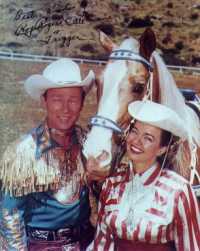What Color is your Horse?
There are five basic body colors of horses. They are:
BROWN A brown horse has a mixture of black and brown in his coat.
In Europe, a "bay" is considered to be a brown horse.
BAY A bay horse can be any shade of brown (which is a mixture of
red and yellow), with points such as tail, mane, muzzle and lower
legs being black. The brown can range from a light, almost tan or
chestnut to a dark, seal color.
BLACK A black horse is completely black, including muzzle and
flanks. Most horses that look black are actually a very dark bay.
CHESTNUT A chestnut horse has brown skin and the hairs are
actually red. The shades vary from a light yellowy color to dark
liver. The mane and tail are usually the same color as the body
but can be lighter. The lighter coloring is called flaxen.
Lighter colored horses are called sorrel; very dark chestnut is
called "liver chestnut".
WHITE A truly white horse is born white and remains white. His
hair is snowy; he has pink skin and blue eyes. Cream horses are a
variation, also having unpigmented skin and pink or blue eyes,
with a pale colored coat. Most "white horses" are actually light
grey.
There are also three major color variations in horses and three
major color breeds.
DUN
Duns have black skin with an evenly distributed coat color
and a black mane and tail, similar to bay coloring. The coat
color can range from a pale yellowish color to the color of a
dirty canvas. Dun horses usually have a dorsal stripe down their
backs and some have stripes on their forearms. The lighter shades
are called buckskin.
GRAY
A gray coat is actually a mixture of black and white hairs
on black skin. A foal may be born a solid color with a few white
hairs sprinkled in his coat, but more white hairs will appear in
the coat until he is gray at maturity. "Dappled grey" looks
mottled, while greys with clusters of darker hair which sometimes
include a reddish brown, are called "flea bitten".
ROAN
Roan is a mixture of white and colored hairs. White with
brown is called red roan; white with red is strawberry roan;
white with black is called blue roan.
PALOMINO
Palominos are golden horses with light colored, or
"flaxen" manes and tails.

PINTO
Pintos have a mixture of white and colored areas on their
bodies. Horses with black and white splotches are called piebald,
while horses with any other color than black are called skewbald.
Pinto is a Spanish word meaning painted. Painted horses are
divided into two categories: Tobianos, the most common, have
white splotches across their backs which extend downward. On
Overos, the white extends from the belly and legs upward toward
the back but does not actually cross the back. Overos often have
a "War Bonnet" or white face.
APPALOOSA
This is a color breed. It is divided into three color
patterns:
Leopard is a white horse with dark spots all over his body;
Snowflake is a dark horse with tiny white spots;
and the "blanket", the most well-known Appy pattern which usually
consists of a white blanket with dark spots on the rump.
Appys must meet three minimum requirements: striped hooves,
unpigmented sclera (white around the cornea of the eye) and
mottling of the skin, particularly on the nostrils, muzzle, and
genitalia. There are solid colored appaloosas but they must meet
the above requirements.
HORSE MARKINGS
Many horses have markings on their faces and legs. Here are the
more common ones.
BLAZE A white mark spread over the forehead and the length of the
face. If the blaze is exaggerated to cover the entire front of
the face, the term "bald face" or "war bonnet" might be used.
STRIPE A white mark down the face, similar to a blaze but
narrower.
STRIP A white mark running partway down the face.
STAR A patch of white on the forehead.
SNIP A white or pink patch on the nose or lip.
WHORL A patch of hair swirling opposite to the surrounding hair,
usually found on the forehead.
SOCK White hair on a leg, looking like human ankle socks.
STOCKING White hair on a leg, extending from hoof to hock or
knee.
A full, legal description of a horse would include: name, age,
color, breed or type, gender, height, parentage, natural marks (such
as those listed above and patches on the body), whorls, acquired
marks such as scars.
This article was kindly provided by Michelle Staples